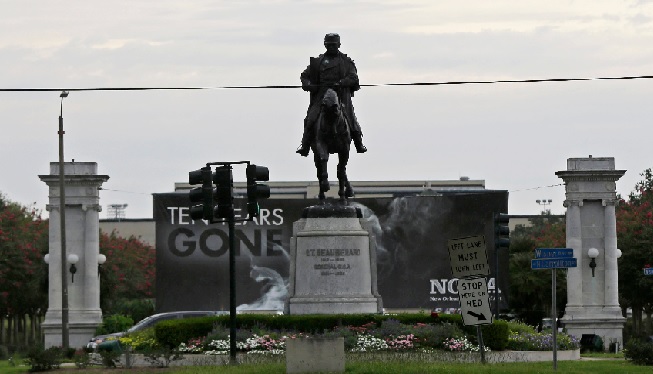NEW ORLEANS — (CNN) New Orleans can remove three Confederate monuments that are displayed in prominent locations, a US federal court ruled on Monday.
A lawsuit had been filed by three historic preservation societies and the local chapter of the Sons of Confederate Veterans seeking to stop the city from removing the statues.
But the US Court of Appeals for the Fifth Circuit rejected their claims as lacking “legal viability or support.” The ruling affirmed a similar decision made by a district court last year.
After the legal victory, the city expects to move swiftly to take down the three Confederate monuments that honor former Confederate President Jefferson Davis, and the Confederate Generals Robert E. Lee and P.G.T. Beauregard. Bids for removing the three statues will be released Tuesday and private dollars are expected to be used, according to the New Orleans mayor’s office.
A fourth controversial monument, called the Battle of Liberty Place monument, cannot be taken down because it’s subject to a federal court order. It’s an obelisk marking a post-war uprising by the White League, a white supremacy group, in a fight against the Reconstruction government in 1874.
After debate over the controversial symbols, the City Council voted in 2015 to remove the four monuments, declaring them to be “nuisances.”
Mayor Mitch Landrieu had said the church slayings in Charleston, South Carolina, moved him to start the monument removal process. The massacre of black worshippers at a church spurred a nationwide discussion about Confederate monuments removal — most of them are located in the South. Dylann Roof, the shooter, venerated the Confederate battle flag.
A lawsuit was filed just hours after the City Council vote, in an effort to stop the removal of the monuments.
The plaintiffs had questioned the ownership of the monuments and the land they sit on. But the federal appeals court reviewed the records showing that the city is the owner. The court also accepted the city’s assurances that the monuments are “merely to be relocated, not destroyed.”
Landrieu praised the court’s decision in a statement, saying it “will allow us to begin to turn a page on our divisive past and chart the course for a more inclusive future.”
“These monuments will be preserved until an appropriate place to display them is determined. Once removed, we will have the opportunity to join together and select new unifying symbols that truly reflect who we are today,” he said.
The plaintiffs expressed disappointment with the ruling, according to a statement released to CNN affiliate WDSU in New Orleans.
The Monumental Task Committee, Louisiana Landmarks Society, Foundation for Historical Louisiana and Beauregard Camp No. 130 are considering whether to ask for a rehearing involving all 14 active judges in the Fifth Circuit Court, as the ruling had been made by a panel of three judges, they said in a statement.
“Despite this setback, the non-profit organizations that filed the original suit will continue to argue that all the City’s historic monuments and cultural sites should be preserved and protected, and that a more appropriate response to calls for the monuments’ removal is a program to include explanatory plaques and markers to present these individuals in the context of their time,” according to their statement.
New Orleans, which was the Confederacy’s largest city, surrendered in 1862 and was under Federal occupation beyond the Civil War’s end in 1865.
The-CNN-Wire ™ & © 2017 Cable News Network, Inc., a Time Warner Company. All rights reserved. (AP Photo/Gerald Herbert)





















